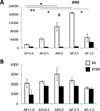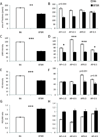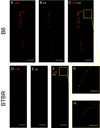Fractone-associated N-sulfated heparan sulfate shows reduced quantity in BTBR T+tf/J mice: a strong model of autism
- PMID: 22101175
- PMCID: PMC3268836
- DOI: 10.1016/j.bbr.2011.11.004
Fractone-associated N-sulfated heparan sulfate shows reduced quantity in BTBR T+tf/J mice: a strong model of autism
Abstract
BTBR T+tf/J (BTBR) mice show abnormal social, communicatory, and repetitive/stereotyped behaviors paralleling many of the symptoms of autism spectrum disorders. BTBR also show agenesis of the corpus callosum (CC) suggesting major perturbations of growth or guidance factors in the dorsal forebrain [1]. Heparan sulfate (HS) is a polysaccaride found in the brain and other animal tissues. It binds to a wide variety of ligands and through these ligands modulates a number of biological processes, including cell proliferation and differentiation, migration and guidance. It is aggregated on fractal-like structures (fractones) in the subventricular zone (SVZ), that may be visualized by laminin immunoreactivity (LAM-ir), as well as by HS immunoreactivity (HS-ir). We report that the lateral ventricles of BTBR mice were drastically reduced in area compared to C57BL/6J (B6) mice while the BTBR SVZ was significantly shorter than that of B6. In addition to much smaller fractones for BTBR, both HS and LAM-ir associated with fractones were significantly reduced in BTBR, and their anterior-posterior distributions were also altered. Finally, the ratio of HS to LAM in individual fractones was significantly higher in BTBR than in B6 mice. These data, in agreement with other findings linking HS to callosal development, suggest that variations in the quantity and distribution of HS in the SVZ of the lateral ventricles may be important modulators of the brain structural abnormalities of BTBR mice, and, potentially, contribute to the behavioral pathologies of these animals.
Copyright © 2011 Elsevier B.V. All rights reserved.
Figures




Similar articles
-
Heparan sulfate deficiency in autistic postmortem brain tissue from the subventricular zone of the lateral ventricles.Behav Brain Res. 2013 Apr 15;243:138-45. doi: 10.1016/j.bbr.2012.12.062. Epub 2013 Jan 11. Behav Brain Res. 2013. PMID: 23318464 Free PMC article.
-
Meningeal/vascular alterations and loss of extracellular matrix in the neurogenic zone of adult BTBR T+ tf/J mice, animal model for autism.Neurosci Lett. 2011 Jul 12;498(3):173-8. doi: 10.1016/j.neulet.2011.05.014. Epub 2011 May 11. Neurosci Lett. 2011. PMID: 21600960
-
BTBR T+tf/J mice: autism-relevant behaviors and reduced fractone-associated heparan sulfate.Neurosci Biobehav Rev. 2012 Jan;36(1):285-96. doi: 10.1016/j.neubiorev.2011.06.008. Epub 2011 Jul 1. Neurosci Biobehav Rev. 2012. PMID: 21741402 Free PMC article.
-
Hippocampus/amygdala alterations, loss of heparan sulfates, fractones and ventricle wall reduction in adult BTBR T+ tf/J mice, animal model for autism.Neurosci Lett. 2012 Jan 11;506(2):208-13. doi: 10.1016/j.neulet.2011.11.007. Epub 2011 Nov 10. Neurosci Lett. 2012. PMID: 22100909
-
The BTBR T+ tf/J mouse model for autism spectrum disorders-in search of biomarkers.Behav Brain Res. 2013 Aug 15;251:25-34. doi: 10.1016/j.bbr.2012.07.021. Epub 2012 Aug 9. Behav Brain Res. 2013. PMID: 22958973 Free PMC article. Review.
Cited by
-
Heparan sulfate deficiency in autistic postmortem brain tissue from the subventricular zone of the lateral ventricles.Behav Brain Res. 2013 Apr 15;243:138-45. doi: 10.1016/j.bbr.2012.12.062. Epub 2013 Jan 11. Behav Brain Res. 2013. PMID: 23318464 Free PMC article.
-
The role of behavior in translational models for psychopathology: functionality and dysfunctional behaviors.Neurosci Biobehav Rev. 2013 Sep;37(8):1567-77. doi: 10.1016/j.neubiorev.2013.06.008. Epub 2013 Jun 18. Neurosci Biobehav Rev. 2013. PMID: 23791787 Free PMC article. Review.
-
The role of heparan sulfate deficiency in autistic phenotype: potential involvement of Slit/Robo/srGAPs-mediated dendritic spine formation.Neural Dev. 2016 Apr 18;11:11. doi: 10.1186/s13064-016-0066-x. Neural Dev. 2016. PMID: 27089953 Free PMC article. Review.
-
Impaired activity-dependent neural circuit assembly and refinement in autism spectrum disorder genetic models.Front Cell Neurosci. 2014 Feb 7;8:30. doi: 10.3389/fncel.2014.00030. eCollection 2014. Front Cell Neurosci. 2014. PMID: 24570656 Free PMC article. Review.
-
Sugar glues for broken neurons.Biomol Concepts. 2013 Jun;4(3):233-57. doi: 10.1515/bmc-2012-0042. Biomol Concepts. 2013. PMID: 25285176 Free PMC article. Review.
References
-
- Wahlsten D, Metten P, Crabbe JC. Survey of 21 inbred mouse strains in two laboratories reveals that BTBR T/+ tf/tf has severely reduced hippocampal commissure and absent corpus callosum. Brain Res. 2003;971(1):47–54. - PubMed
-
- Fombonne E. Epidemiological surveys of autism and other pervasive developmental disorders: an update. J Autism Dev Disord. 2003;33:365–382. - PubMed
-
- Maenner MJ, Durkin MS. Trends in the prevalence of autism on the basis of special education data. Pediatrics. 2010;126(5):1018–1025. - PubMed
-
- Maughan B, Iervolino AC, Collishaw S. Time trends in child and adolescent mental disorders. Curr Opin Psychiatry. 2005;18:381–385. - PubMed
-
- Rutter M. Autism research: lessons from the past and prospects for the future. J Autism Dev Disord. 2005;35:241–257. - PubMed
Publication types
MeSH terms
Substances
Grants and funding
LinkOut - more resources
Full Text Sources
Molecular Biology Databases
Miscellaneous

